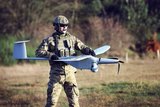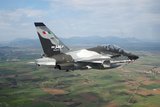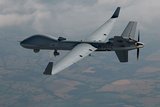UK brings 90 companies into $1.25 billion hypersonic missile programme
The UK is looking to develop an indigenous hypersonic capability. (Image: DE&S)
Ninety companies have been accepted into the UK’s £1 billion HTCDF agreement, set up to rapidly develop advanced hypersonic missile capabilities where firrns can bid for contracts within the programme.
The framework agreement is designed to provide a faster route to achieve capability and will select suppliers all the way through to a final weapon system with the award of contracts managed through competitive processes at the MoD's DE&S agency.
The framework hopes to enable focussed research to be spirally developed through varying Technology Readiness Levels (TRLs) from very low to ready for operations, specifically TRL 1-9.
The HTCDF will reopen to new suppliers every six to 12 months so the MoD can draw upon new technologies and emerging market capabilities.
Alongside established weapons manufacturers and academic institutions, nearly half of the suppliers will be small and medium enterprises and, according to DE&S, this is designed “to leverage the strength and breadth of UK and international talent and innovation across the defence enterprise".
More from Air Warfare
-
![Poland air report: Drones, transport aircraft and tankers dominate potential procurement plans]()
Poland air report: Drones, transport aircraft and tankers dominate potential procurement plans
With a rising defence budget and equipment list, Poland’s air market is set to grow as the country continues to modernise its transport and helicopter fleets while seeking out uncrewed aerial vehicles and loitering munitions.
-
![Portugal signals interest in establishing A-29N final assembly line]()
Portugal signals interest in establishing A-29N final assembly line
As the launch customer for the NATO-configured variant, Portugal also took delivery of the first five A-29N aircraft from its order for 12, placed in 2024.
-
![Podcast: Critical Care episode 5 - Sustaining Europe’s frontline from Heidelberg]()
Podcast: Critical Care episode 5 - Sustaining Europe’s frontline from Heidelberg
As Europe ramps up defence investment in the wake of the Ukraine crisis, the spotlight is turning to how nations sustain their growing fleets.
-
![Leonardo signs contract on Austria’s M-346 aircraft order]()
Leonardo signs contract on Austria’s M-346 aircraft order
The first of the 12 M-346 aircraft are expected to be delivered to the Austrian Air Force by 2028, according to the company.
-
![2025 UAV market review: $7.8 billion in new contracts signed as US leads spending]()
2025 UAV market review: $7.8 billion in new contracts signed as US leads spending
Qatar and Indonesia followed the US’s high spending on new uncrewed aerial vehicle contracts across 2025, while MALE and micro drones and loitering munitions were particularly popular subcategories this year.
-
![German Navy in “ramp-up” phase as it welcomes first NH90 Sea Tiger delivery]()
German Navy in “ramp-up” phase as it welcomes first NH90 Sea Tiger delivery
With all 31 aircraft set to be delivered by 2030, the helicopters will gradually replace the ageing Sea Lynx fleet which are due to be retired in 2026.






















